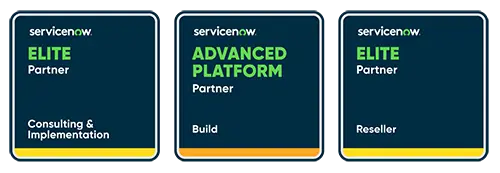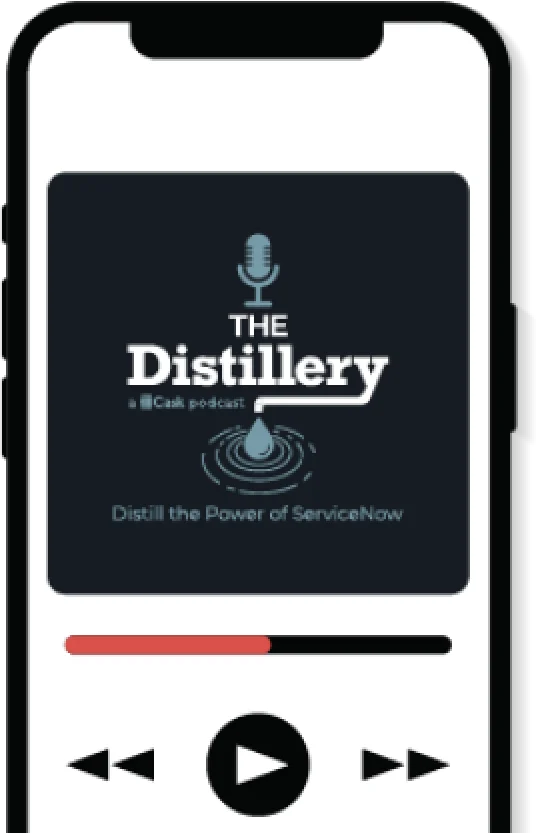Your Host:
Sean Dawson
Our Guest:
Christine Morris & Megan Harter
Are you new to GenAI or still in the early stages of implementing it in your practice? You’re in an exciting stage in your journey! In this episode of the Distillery, host Sean Dawson speaks with Christine Morris (Senior Director of Technical Service Innovation, Cask NX) and Megan Harter (Senior Director of Transformations, Cask NX) about common misconceptions about GenAI, what sets it apart from past tech trends, and best practices for making your GenAI journey with ServiceNow a success.
Sean Dawson: Hello, and welcome to the Cask Distillery Podcast once again, where we unlock the full potential of ServiceNow with expert insights and practical strategies, only here on the Cask Distillery Podcast. So thanks for joining us so much in watching another episode. And in this episode, we’re going to talk about the ServiceNow GenAI journey and what you need to know.
I have a couple of guests with me. It’s Megan and Christine, and I’m going to have them introduce themselves in just a minute. And I’m excited to talk about ServiceNow GenAI and really what it means for organizations, and clear up some misconceptions, and give you practical advice on getting started.
So welcome, Megan and Christine and I was hoping you could—you’re going to do better than I do—give a quick intro for everybody for you—just a sentence or two, really quick—on your background and what you do here at Cask with me.
Christine Morris: Sure. I’ll get us started. Christine Morris. I am senior director of Cask. I lead our ITX practice. So that includes ITSM, ITAM, ITOM, as well as our security and risk group. I’ve spent many years on the platform. I started the Richmond ServiceNow user group and served as the leader of that for several years. And I tell folks, “I’m not just a user; I’m a groupie.” So it’s great to be here.
Sean Dawson: Yeah, thanks. Megan?
Megan Harter: Megan Harter. I’m the senior director of transformations here at Cask. And that encompasses transformational consulting, app services, and our mission-critical solutions branches in our organization. I have been on the ServiceNow platform for about 11 years. I also was a platform owner. And I’ve held a variety of different roles with a strong emphasis in product and program management. And I’m excited to talk about AI and what that means for you from a journey perspective today.
Sean Dawson: Yeah. And thanks for joining us, for taking time out of both of your busy schedules, because we’re all busy. Thank you so much. So let’s go ahead and kick this off. And I wanted to talk about what is the GenAI journey in general. And really, what does it mean for organizations today?
Megan Harter: So when we talk about the GenAI journey, we’re really talking about the process of adopting, learning, and optimizing generative AI within an organization. It’s not just about turning on an AI tool and expecting instant transformation. It really is a process. For companies today, that really means exploring where AI makes sense, where can it save time or improve outcomes. Running pilots, right? Starting small and seeing what works before going bigger. Fine-tuning your AI models—because AI always needs some human oversight—and helping people adapt. AI isn’t here to replace jobs, but it does change how we work.
Christine Morris: Right. It’s a marathon, not a sprint.
Sean Dawson:Yeah, I totally get that. So why do you think there is so much hype around GenAI. And really, honestly, is it justified?
Christine Morris: You know, AI is everywhere right now. Why? Right? Because for the first time, we have AI that can create content, automate tasks, and assist with decision-making in ways that feel humanlike. And yes, some of the hype is absolutely justified. Generative AI is already improving productivity, cutting down response times and IT service tasks, and just helping businesses really personalize those customer interactions.
Megan Harter: Here’s the thing, right? AI isn’t magic. If companies expect instant results without any effort, they’re really going to be disappointed. The real power comes when AI is paired with strategy and human expertise together.
Sean Dawson: So with that, what do you think? I don’t know, what are the biggest misconceptions about GenAI?
Megan Harter: Oh my gosh, there are so many. Here are a few that we hear all the time. “AI will replace my job.” Right? I think that’s a huge concern. The fact of the matter is AI is here to assist, automate that repetitive work, and let people focus on what really matters.
“AI just works right out of the box.” Nope. We wish that was true. AI is really only as good as the data that it’s trained on. If you feed it bad data, you’re going to get bad results and not see the outcomes that you’re looking for.
“We don’t need governance.” Think again. AI really needs those guardrails. It doesn’t know everything and it’s learning. Security, compliance, and ethical AI practices are really critical to ensuring you have a sound program.
“One AI model fits all.” Not true at all. AI needs to be tailored to your business to really shine.
Christine Morris: Yeah. And if you’re implementing AI, you really need to go in with your eyes open and have a solid plan.
Sean Dawson: Yeah. And as we’re talking about this, I think about all the different tech—the three of us have been in tech for many, many years. I think about all the different stuff—widgets—stuff that’s come out. How is GenAI different from past overhyped tech trends?
Christine Morris: Well, we’ve all seen technology trends come and go, right? Blockchain, AR, VR, even early AI models. They all had some promise, but many never really fully delivered on the hype. What makes GenAI different is that it’s actually useful today. It’s not just theoretical. It’s already helping customers and companies automate, summarize, and enhance their workloads. And because it’s built into the platforms like ServiceNow, you don’t have to be a data scientist to benefit from it.
Sean Dawson: Yeah, it’s a little more accessible. So how should organizations prepare for GenAI?
Megan Harter: So if you’re thinking about adopting AI, you might be wondering where to start. First, you want to identify the right use cases. You don’t want to just adopt AI because it’s trending or the current business keyword that’s buzzing around. You want to find places where it really will actually help you save time, reduce errors, and improve service. That’s really where it is strong. You want to start small, run a pilot, maybe AI-assisted ticket summarization or AI-powered knowledge search. Learn what works before you start scaling up and going big.
Christine Morris: I think the other huge part of it is getting your data in shape. I think, as Megan indicated earlier, it runs on good data. So if you don’t have good practices, if your data is messy, if it’s inconsistent, your AI is going to be messy too. We want to make sure that you’re educating your teams. AI is a tool, but people need to understand how to use it effectively. And then, of course, you really want to keep an eye on governance and making sure that AI is being used ethically and securely within your organization. And AI is really only as useful as the data it has access to. When AI’s inside ServiceNow, it can work directly with your IT, HR, and customer service data in real time, meaning more accurate, relevant results.
Megan Harter: Yeah, and if AI is outside of your platform, you have to figure out how to integrate it, secure it, and train it properly, which can take a lot of time and effort up front. The big advantage is that embedded AI in ServiceNow means that you don’t have to reinvent the wheel. It’s already connected to your workflows, already secure, and already optimized for real business use cases.
Sean Dawson: And I’m thinking about the companies that are just starting out, just looking at this. They’re just starting out with ITSM, starting out with HRSD, whatever it is. What advice do you have for companies that are just starting their GenAI journey?
Christine Morris: If you’re just getting started, you really don’t want to overthink it, right? Start with one or two AI-driven automations and really build from there. You also want to get people involved early. There’s a huge element of fear with AI. “It’s going to replace my job.” And the sooner that your team gets comfortable with AI, the smoother that adoption is going to be.
And be patient. AI gets better over time, but it really needs those real-world components to improve. You want to measure your results. This is a big thing in every implementation that we go into. People just, “Let’s turn it on, see what happens.” No, we want to make sure that we are tracking our efficiency gains. We’re understanding how it’s bringing in cost savings, understanding the user satisfaction and how that can improve your AI’s value.
Sean Dawson: So what would you say to companies that have already implemented GenAI? So someone that’s already a little bit more mature.
Megan Harter: For those who have already gotten started, that’s awesome. But now is the time to ask yourself some critical questions to see if you’re getting the value out of your implementation that you’re looking for. Are we actually solving problems or just using AI for the sake of it? If it’s not improving processes, maybe you want to refine your approach.
You want to think about are you continuously improving your models? AI doesn’t just set and forget. It needs regular tuning.
Are employees actually using it? Adoption is really critical. If people don’t trust or understand the AI, they’re not going to use it effectively, and it’s just going to become something that was just a buzzword.
[And are we tracking that ROI? If you’re not seeing any measurable benefits, it’s really time to adjust your strategy and how you’re approaching things to get the most value out of what you’ve implemented in general.
Sean Dawson: Great. Thank you for that. And thank you again for your time. With that, in closing, the GenAI journey isn’t about chasing trends. It’s about creating real value. ServiceNow’s embedded AI really does make it easier than ever to get started and see meaningful results. If you’re just getting started, focus on practical AI adoption, governance, continuous learning. If you’re already using AI, make sure it’s delivering real, measurable impact.
So thanks for joining this discussion. Let’s keep the conversation going. Drop us a comment. Chat. Like it. Get a hold of us. Let us know what else you want to hear. And thank you so much for joining us. Thank you, Megan and Christine, again for joining us on your busy schedule. And again, thank you everybody that watches and listens. Take care. Bye bye.
Christine Morris: Bye, everyone.
Megan Harter: Bye.
We’re with you for what comes next
You're working in a rapidly shifting environment.
Global dynamics, AI advancements, heavy competition–the only certainty is change.
We get it. And we’re here to help you harness the full potential of ServiceNow to simplify transformation.
Let's navigate the future together.

Recent Episodes
We’re with you for what comes next
You're working in a rapidly shifting environment.
Global dynamics, AI advancements, heavy competition–the only certainty is change.
We get it. And we’re here to help you harness the full potential of ServiceNow to simplify transformation.
Let's navigate the future together.

Let’s Innovate Together!
Request a Complimentary Consultation from Cask.
Cask’s unparalleled expertise is ready to tackle your unique challenges and transform your aspirations into reality. We’ll listen to understand your requirements and offer a tailor-made approach that aligns with your strategic objectives.
Your journey to innovation is just a click away. Schedule your meeting with our Cask advisors and become part of the success story that defines your organization’s future.

Sign up for our Distillery Podcast
Stay up to date with the latest episodes







